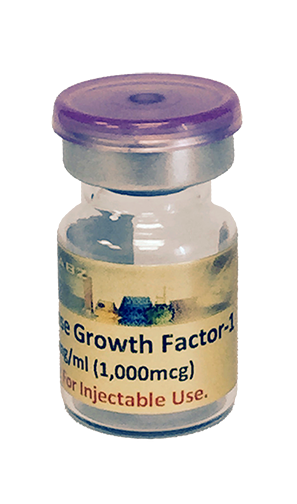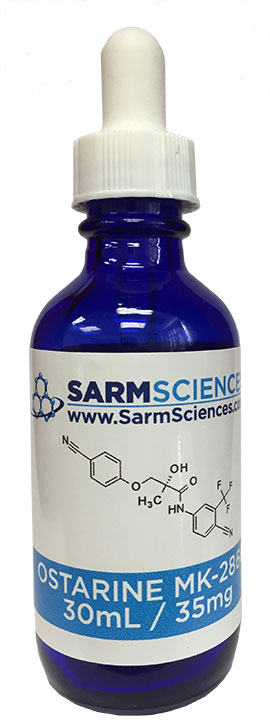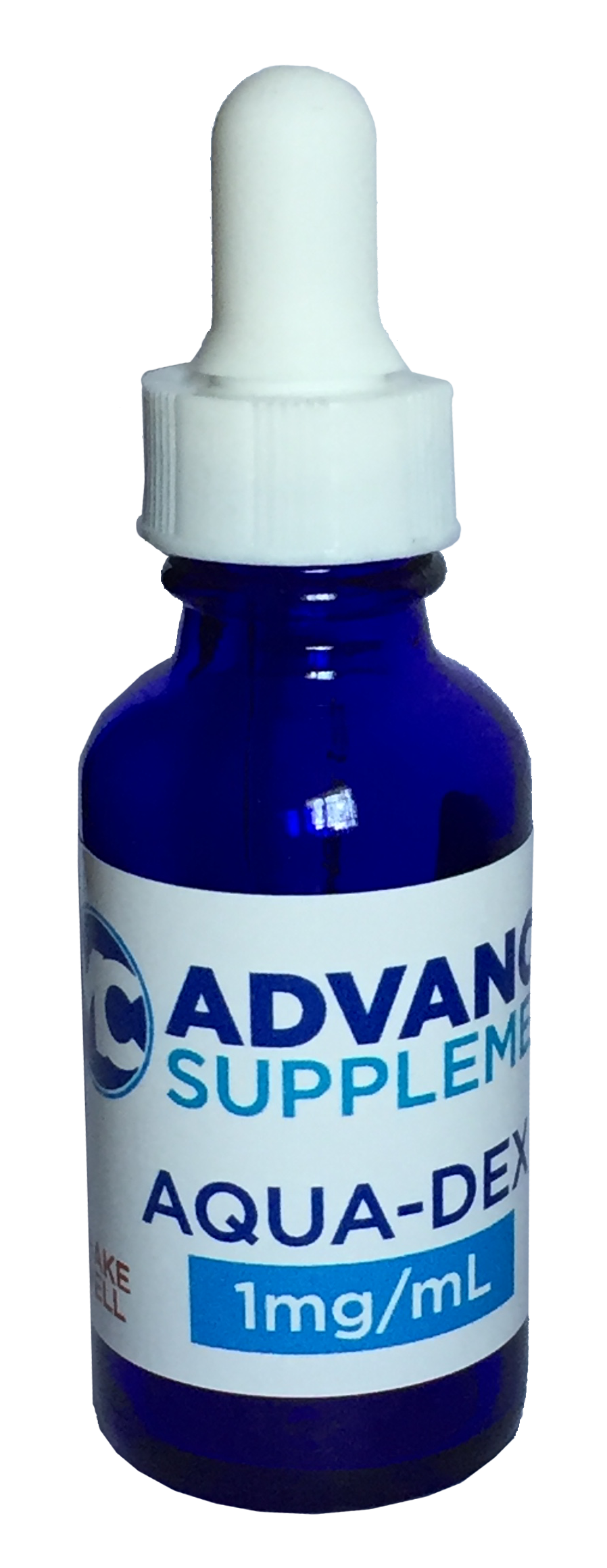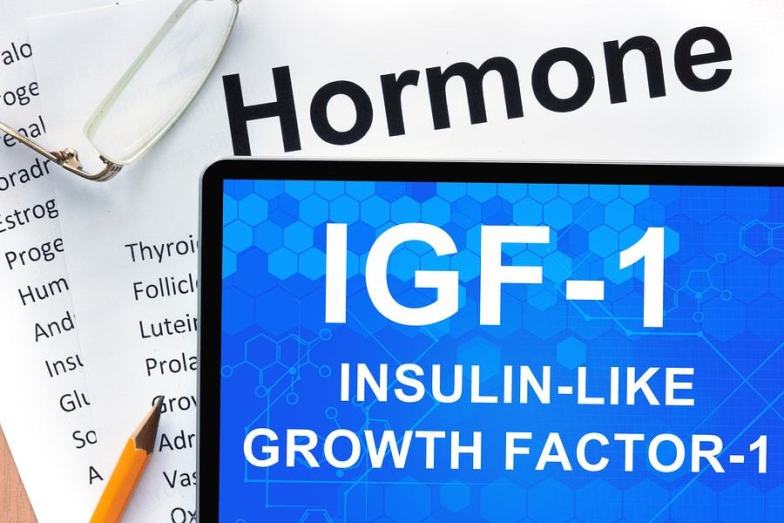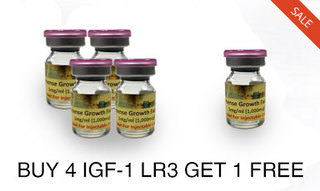IGF-1 Guide
IGF 1 Lr3, Insulin, Human Growth Hormone (HGH) Tutorial
IGF-1 lr3 Customer Reviews By the Thousands
I have to admit, I was one of the last to jump on the Peptides bandwagon. I just wasn’t impressed by the results people had been talking about over the last few years. Sure, the guys in the IFBB have been getting bigger and bigger as the years have been going by, as have NPC competitors, but I still wasn’t convinced that it was from the hGH (human Growth Hormone, also called “GH”), the insulin, or the IGF-1 (insulin-like growth factor). Besides, guys were getting pretty huge before that stuff was readily available, so I wasn’t ready to buy into Growth Factors and Peptides just yet.
I was in my late teens when hGH just started getting really popular, and just started becoming the “must have” drug for contest prep…In fact, even a decade later, most bodybuilders still consider hGH almost a necessity for contest prep, and many use the full spectrum of Growth Factors (Insulin, IGF-1, hGH) virtually year round. But still, from talking to regular bodybuilders, I wasn’t impressed. Most people who I spoke to (who weren’t professional bodybuilders or top amateurs) said that growth factors simply didn’t give them the same results as steroids did. Personally, I didn’t see the rationale behind paying a couple of hundred dollars for something which wouldn’t even produce the same results as a couple dollars worth of testosterone. Well…
I think that’s because a lot of people simply use Growth Factors incorrectly…because properly used, I think that they are highly potent and impressive drugs for both athletics as well as bodybuilding.
In other words, I was wrong. Sort of. See, I think that the reason we’re seeing mixed results from people using Peptides is their doses and dosing protocols. So what I’m going to do here is basically give you an overview of the various peptides on the market, and let you in on the optimal time, dose, and combination I think will allow them to produce the best possible results. Basically, what I’m going to do is tell you about all of the new peptides on the market, and how they are used for maximum results.
IGF-1 Guide to understand how to properly use them, first a brief explanation of how they function naturally may be in order. Natural GH levels are controlled by several stimuli including both neurotransmitters as well as hormones. Increasing your body’s natural GH level is first initiated in the hypothalamus. There, in the hypothalamus, two peptide hormones act to either increase or decrease GH output from the pituitary gland; these hormones are known respectively as somatostatin (SS) and growth hormone-releasing hormone (GHRH) – and they have opposing effects. Somatostatin acts at the pituitary to decrease hGH output while GHRH acts at the pituitary to increase hGH output. Together these hormones are secreted in pulses to regulate your body’s hGH levels. In this way, your body can either cause the secretion or inhibition of hGH from the pituitary, as necessary.
When there isn’t enough hGH in your body, GHRH acts to initiate the emission of hGH, and when there is too much hGH in the body, somatostatin does the opposite. The latter effect occurs because hGH is subject to a negative feedback loop. When GHRH is released, it causes a hormonal cascade starting with the subsequent secretion of hGH. Once that hGH is released, exerts various metabolic effects…and it triggers the release of IGF-1, which is now known to exert many of the effects previously attributed solely to hGH. (1) IGF-1 is highly anabolic although a large body of contradictory literature exists on the topic of whether hGH is anabolic per se. Regardless, though I personally feel that enough evidence exists to show that Lr3IGF-1 is more potent for building muscle than hGH is (Note: Lr3IGF-1 is 2-3x more potent than regular IGF-1).
Now, with regards to GH as well as IGF-1, after they’re produced and secreted, they then have the ability to circulate back to the hypothalamus as well as the pituitary to initiate somatostatin release. As previously stated, the secretion of somatostatin will complete the negative feedback loop, and decrease hGH release. Although both hGH as well as IGF-1 can do this, and have many other overlapping effects, they seem to be able to produce many divergent effects as well, and individually they would seem to act in both an autocrine and paracrine fashion (meaning they can apparently affect various cells and their neighboring cells without it having to enter the actual cell). This is likely how IGF-1 causes a decrease in body fat, though there are no IGF-1 receptors in fat cells. hGH, on the other hand reduces fat through the hGH receptors found in fat cells. (1) IGF-1, however, is thought to be the primary autocrine/paracrine catalyst in myofiber (muscle) growth, also called “myogenesis” (generation of new muscle tissue).
To understand autocrine/paracrine signaling involved in muscle (myofiber) regeneration and growth, we can point to the various hypertrophic (growth promoting) effects which appear to be totally modulated by IGF-1. When muscle is broken down by training, the destruction of muscle tissue leaves behind something known as “satellite cells”. Those satellite cells are small stem cells located within the muscle which are then mobilized by IGF-1 to begin the muscle growth and regeneration process. During this process of regenerating muscle, myoblasts are formed to replace and hypercompensate for damaged/destroyed ones, and then they can either fuse with each other to form totally new myofibers or become incorporated into previously damaged (surviving) myofibers. Ultimately, if more myofibers are created than were destroyed (by training) new muscle growth is experienced.
IGF-I and “myogenesis” during compensatory hypertrophy. Increased loading leads to satellite cell proliferation, differentiation, and fusion. IGF-I has been shown to stimulate these myogeninc processes in skeletal muscles. It is postulated that IGF-I, and/or the loading-sensitive IGF-I isoform Mechano growth factor (MGF), is produced and released by myofibers in response to increased loading or stretch. The increased local concentration of IGF-I (MGF) would then stimulate the myogenic processes needed to drive the hypertrophy response. (Adams J Appl Physiol 93: 1159-1167, 2002; doi:10.1152/japplphysiol.01264.2001
8750-7587/02 $)
Though IGF-1’s effects on the creation of new muscle tissue are clear and direct, it would appear that hGH probably exerts the majority of its anabolic effects on muscular tissues through its ability to stimulate the secretion of IGF. Although it’s also speculated that there could also be an additional (and direct) effect exerted by hGH on muscle as well, though this has been difficult to prove for scientists.
As we already know, the production of IGF-1 probably occurs when hGH is first released from the pituitary (or injected), then travels to the liver and other muscle tissue where it influences the synthesis and subsequent release of IGF-1. We know that the newly secreted IGF-1 then travels in the blood to the target tissues after being released from the cells that produced it (in the liver, in this case, but also in muscle tissue when you train).
Although all of this seems promising, and I previously had read about the GH/IGF axis, I just hadn’t been a fan of either hGH or IGF-1, because of their relatively high cost, compared to other anabolic compounds. I had also been hearing less than amazing results being reported from some people using IGF (remember, in my estimation, I now think that those people were using it poorly, as regards timing and dosing). I’ve actually been interviewing dozens of bodybuilders and athletes, and trying to figure out what kind of doses and dosing protocol the most successful use of IGF has been. Now that I’ve figured out exactly how to use IGF and other peptides for optimal results, I think that they are really quite remarkable. Just hang on, because I’m getting around to telling you how to use them…But first, I need to go over a bit more about IGF, and how it isn’t only produced in the liver.
This is possibly the most important part about production of IGF-1…all of the production/secretion of it isn’t actually done in the liver. And this last fact brings up an interesting (and very relevant) point about IGF…and that is the idea that it can be locally produced in alternate splices in muscle tissue as a response to training (2). While liver produced IGF-1 has several important systemic (total body) effects, when it is produced locally (in muscle) it has several different physiological functions (but mainly we’re concerned with muscle growth and development, and fat loss).
Lets take a look at what happens when you resistance train, and look at how your body responds hormonally. As you can see from the following chart, both eccentric as well as concentric movements will raise IGF-1 levels, as well as IGF-1 receptor concentration levels, while also lowering levels of some IGF binding proteins like IGFBP-4 (which serves to temporarily deactivate IGF-1, possibly inhibiting its actions):
(Chart from: Am J Physiol Endocrinol Metab 280: E383-E390, 2001; 0193-1849/01)
Also of note is that skeletal muscle IGF-I mRNA and protein expression both increase during mechanical loading (2), thus indicating that the locally produced IGF-1 is not exactly the same as liver produced IGF…nor is the liver the only source of IGF-I. This is very important to us here. In fact, a review of this evidence makes it highly unlikely that increases in liver produced IGF-I are necessary for hypertrophy and instead, we find a much higher correlation in new muscle mass with locally produced IGF. (3)
This locally produced IGF is extremely likely to cause myogenesis during skeletal muscle hypertrophy by contributing to at least by three important molecular processes:
1. increased satellite cell activity
2. gene transcription
3. protein translation
Each of these processes contributes in a different manner to local and general muscle growth. It is highly likely that IGF-I, through each of these three processes, directly and significantly contributes to hypertrophy. So we can see that once IGF-1 is produced in the muscle, by mechanical stimulation (resistance training) the gene is actually slightly different than liver produced IGF-1…this indicates that the IGF-1 gene can actually be “spliced” into different forms, to produce divergent effects on the hypertrophy response. (4)
So we know that there are different forms of IGF-1, caused by gene splicing, which have now been identified to follow resistance training. Basically, this means that different isoforms (forms) of the IGF-I gene have been shown to be expressed by muscles when subjected to mechanical stimulation. In other words, when you lift weights, varying “versions” of the same basic IGF-1 gene are created out of the IGF-1 which is secreted. This brings us to the dominant isoform of IGF-1 which is expressed primarily during mechanical overload: Mechano Growth Factor, or MGF. (3)
However, before going on, it is important to keep in mind that these isoforms of the human IGF-1 gene (some of which are IGF-1Ea, b, and c) are all very similar to each other and all have the ability to produce slightly different (though important) effects which aid muscle growth.
However, when examining all of these different isoforms, it would seem that the primary growth factor responsible for the hypertrophy process is insulin-like growth factor (IGF-I) and MGF, or Mechano Growth Factor (IGF-1Ec). (7)
Actually, though, even though MGF seems to be the most important isoforms of IGF-1, there are two isoforms which appear very relevant to hypertrophy are: IGF-1Ea (sometimes termed “muscle IGF-1”) which is actually similar to the IGF-I produced by the liver, and as already mentioned, IGF-IEc (termed mechano-growth factor and known to bodybuilders and athletes simply as “MGF”). (3) The latter of those two only appears to be produced by damaged, stretched, or loaded muscle tissue (5-7), as a repair/rebuilding mechanism. Although, the actual mechanistic roles of these different isoforms of IGF-1 as regards muscular hypertrophy are still regarded as quite complex and not well understood, IGF-1 (and specifically these isoforms of IGF-1) could actually be the most important contributor to skeletal muscle hypertrophy.
Before I go on to my personal preferences on how to use IGF-1 and MGF, I think I should clearly state that I feel that the combination of those two (or even either one alone) is far superior to the use of hGH, for most purposes. In fact, lately I’ve been getting quite a bit of heat over my recommendations to use a combination of Lr3IGF-1 and MGF in lieu of hGH, and I think that at this point, it’s not too difficult to understand why I consider IGF-1 and MFG to be a very potent combination for muscular growth- far superior to hGH. IGF-1’s superiority to hGh is intuitive at some level, but has also been clearly elucidated clinically as well. In the following graphs taken from a rodent study comparing IGF-1 and hGH, a low dose as well as a high dose of IGF-1 was shown to be more anabolic than hGH. In comparison to hGH, IGF-1 produced an overall greater total protein content within the injected muscle as well as a greater final weight of the that muscle (called the “Tibialis Anterior” or TA) (9):
So, in comparison (in this study), it seems to be the case that IGF-1 would be superior to hGH as an anabolic agent. In some clinical studies, that is not always the case, but in bodybuilders and athletes I’ve spoken to, greater results are often seen with IGF-1 over hGH – and it should be noted that they are often seen more quickly as well. And while an intact insulin and IGF-1 Receptor signaling system is necessary for hGH to produce an anabolic effect (10), an hGH receptor deficiency is not sufficient to stop IGF-1 from being anabolic. (11) This is another reason to believe that when you are using hGH, you’re really just hoping that it produces IGF-1, for an anabolic effect.
There’s also another important reason I favor the use of IGF-1/MGF instead of hGH. Over the past few decades, hGH has developed quite a reputation for taking awhile (often several weeks) for the user to start seeing results. In contrast, IGF-1 often begins to product noticeable results within the first couple of weeks. When talking to people who have used both, I’m finding that the current trend is leaning towards IGF-1 use. At this point I should note that the IGF-1 use that’s most popular (and the kind I would recommend) is always the Lr3IGF-1 version.
Although it’s a fairly new peptide, recent studies drawing the comparison between IGF-1 and MGF have concluded that MGF is even quicker to produce results. (4) Actually, it’s been found in rodent studies to produce both faster and better results with regards to muscle growth, compared to IGF-1. (4)
Now that I think I’ve stated my case for IGF and MGF being used instead of hGH, I’ll tell you how I personally have used them successfully- and where my dosing protocol comes from. I’ve been noticing that the bodybuilders who are getting the best results from both Lr3IGF-1 as well as MGF are using it after workouts. So first of all, my recommendation is to inject them after working out. You’ll be getting better results by using them by injecting at this time because after mechanical loading (weight training with CONcentric and ECCentric loads), your levels of specific IGF-binding proteins (like IGFBP-4 are lower) (12). IGFBP-4 is a protein which binds to IGF-1 and inhibits its anabolic effects. As you can see from the picture below, levels of IGFBP-4 are lower following both concentric as well as eccentric movements, than pre-workout:
Thus, it makes sense that you’ll get better results by injecting when levels of IGFBP-4 are lower than usual. In addition, at this time (right after a workout), IGF-1 levels are high (particularly MGF), and I feel that an additional spike in those levels would aid in the body’s ability to induce myogenesis and therefore hypertrophy. If I’m going to spend the money on IGF-1 and MGF, I’d rather inject them when binding protein levels are lowest, and they can have their maximum effect- and that means injecting them after a workout which contains a stretch component, as well as eccentric and concentric loads.
This is why I recommend shooting MGF immediately post workout, when natural levels of it are already elevated. The addition of extra MGF should push more satellite cells towards the formation of new muscle tissue, and I firmly believe that maximal benefits from this compound won’t be experienced if it’s not used after the muscle has been broken down and overloaded with training. After all, MGF is a repair factor, and I think it’s only logical to conclude that it should be used when muscle repair is going to (hopefully) be taking place anyway.
Next, I recommend using Lr3IGF-1 about an hour later…because at this point, although MGF is still highly elevated, we can still derive a benefit from adding in some IGF-1, which will then be spliced appropriately into the isoforms which are most needed by the body. When we look at both young and old subjects who are resistance trained, we see that the highest MGF levels correspond with the lowest IGF- 1Ea levels (5):
This is why I think that by introducing an excess of MGF into the body, followed by IGF-1 which will then be spliced appropriately, will produce the additional activation of satellite cells, protein translation, and gene transcription will force the body to produce much more new tissue than if MGF or IGF are used at any other point during the day, or in a different sequence.
So how much is being used? Well, in talking with bodybuilders and other athletes, I’m finding that the magic starts with these drugs at about 80-100mcgs, which is injected into the primary muscle trained in the preceding workout- half going into that muscle on one side of the body, the other half going into the mirror image of that muscle on the other side. At this point, adequate protein and carbs need to be ingested, because IGF-1 is only going to be effective when there is adequate protein in the body to build new tissue from.(13)
So those are my full recommendations, and reasons behind them. IGF-1 (especially Lr3IGF-1) and MGF are going to be more effective than hGH, for muscle growth, and if you use them in the way I’ve outlined, you’re going to take advantage of your lowest levels of inhibitory binding proteins (thus allowing the peptides to exert maximal effects), while giving your body the best possible environment to create new muscle tissue from your workouts.
So as I said in the beginning of this article, I wasn’t the first to jump on the peptide bandwagon- but now that I figured out how to use them, they’re becoming an increasingly large (and successful) part of my anabolic intake. If you’re interested in trying them for the first time, or have used them in the past with less than great results…give my protocol a try. You won’t be disappointed.
